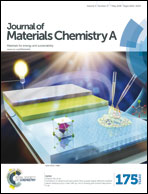Enhanced photoelectrochemical water splitting via SILAR-deposited Ti-doped hematite thin films with an FeOOH overlayer†
Abstract
Hematite (α-Fe2O3) has been intensely investigated for photoelectrochemical (PEC) water splitting, but diffusion of metal atoms from underlying layers often obscures the nature of improvements induced by intentional dopants and overlayers. Here we provide insight into the effects of Ti doping and FeOOH overlayers using hematite films with well-controlled, uniform doping profiles fabricated by successive ionic layer adsorption and reaction (SILAR) followed by annealing at 600 °C. An optimum Ti concentration of 4.2% in the film doubled overall charge separation efficiency to 20% compared to undoped hematite by enhancing band bending. With Ti, carriers generated within 3 nm of the depletion region were separated with near-unity efficiency. Moreover, Ti improved interfacial hole transfer efficiency from <3% to 80% by increasing the concentration of surface-trapped holes that act as water oxidation intermediates. This effect is amplified by FeOOH, which increased hole transfer efficiency to ∼100%. The combination of Ti doping and FeOOH overlayer resulted in photocurrents of 0.85 mA cm−2 at 1.23 VRHE and >1.0 mA cm−2 at 1.50 VRHE, which are competitive with champion planar hematite films. The approach for fabrication and analysis reported here can be applied to a wide range of materials to improve fundamental understanding and performance of PEC systems.


 Please wait while we load your content...
Please wait while we load your content...